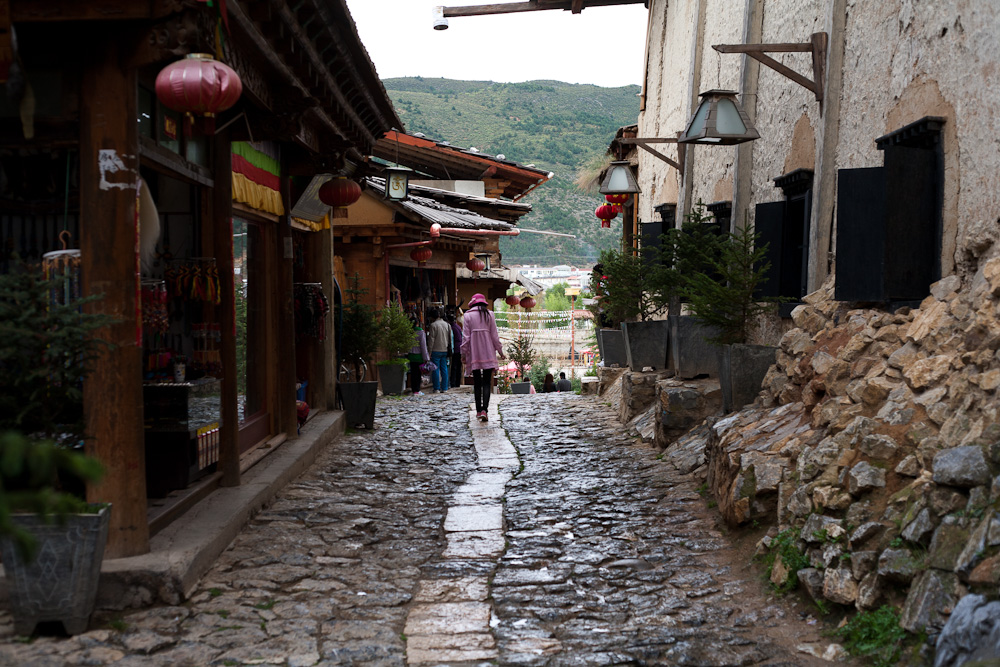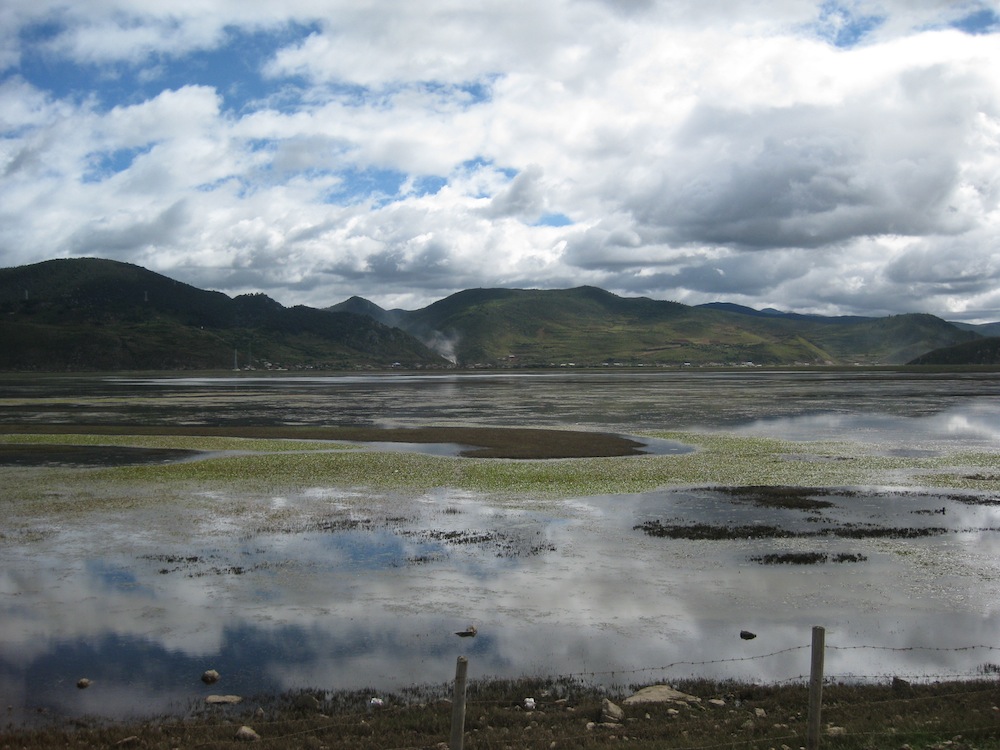Finding Shangri-La
July 19th, 2013

We drove up, into the mountains, winding our way through deep ravines and over rushing rivers. As we climbed higher, the brick red earth that dominates the landscape in most of Yunnan turned to a dark, nearly black soil, and the stands of bamboo that covered the mountainsides gave way to forests of scrubby pines. Suddenly, we crested a mountain and found ourselves in a wide alpine field. The plain was dotted with dark red plants and shallow lakes. Yaks and horses wandered about, grazing freely, the bells on their collars and harnesses sending a tinkling sound through the thin air. Every so often we passed a cluster of tall, sturdy houses with packed earth walls and huge timber beams holding up their roofs. Spire-topped white stupas wrapped in colorful prayer flags marked major crossings in the road.

The fields and villages of Shangri-la County
This was Tibet. Except that it wasn’t, at least not officially. It was the Shangri-la Country, part of the Dêqên Tibetan Autonomous Prefecture in northern Yunnan. Like parts of Sichuan and Qinghai, the northwestern-most point of Yunnan, which sticks up into the Tibetan Plateau, is more Tibetan than Chinese, despite the fact that it’s outside the official Tibetan Autonomous Region (TAR). But as a part of Yunnan, it’s accessible to anyone who gets a tourist visa to China and might want to explore the Tibetan culture without dealing with the hassles and restrictions the government imposes on visitors to the TAR.
I had gone to Shangri-la with my mother and her partner as part of a week-long trip that took us from Kunming to Dali, and Shaxi, and then on up to this beautiful, unique part of Yunnan, which I had never visited before. Our home for the visit was an old Tibetan house owned by a Chinese woman named Hazel who had updated the stone and wood-timber building with large windows and modern baths but kept all the other original details in place. The house was gorgeous, but I was a little conflicted about staying there. If I’m in Tibet, I thought, shouldn’t I be staying with Tibetan hosts?

Shangri-la Old Town
This problem—the tension between wanting to explore the area’s Tibetan culture and the reality of the mainland Chinese presence in the area—defines visitors’ experiences in the area. Or at least it defined mine. Everywhere we went, the issue presented itself. The old town of Shangri-la (known to Tibetans and Gyalthang, and known to the Chinese as Zhongdian until 2001, when it was renamed to attract tourism) is a lovely warren of traditional houses that have been turned into cafes and shops selling Tibetan art, jewelry, and handicrafts. But most of these businesses are not owned by local Tibetans; they simply rent out their old houses to the Chinese who have descended on the city, hopeful of making money out of the area’s growing tourism industry. In some ways, this must be good for the locals, who benefit from the rental income, but the invading army of shopkeepers and hotel owners change the character of the town and the culture of those who have traditionally lived there.

A view of Songzanlin Temple, from a distance
My solution for coping with this problem varied as the visit progressed. At times, we avoided the most touristy spots. We canceled our planned excursion to Songzanlin Monastery (松赞林寺, Sōngzànlínsì, also called Ganden Sumtseling Monastery by Tibetans) when we reached the in-town ticket office and realized that the monastery, once a center of Tibetan culture, was now primarily a tourist destination overrun by Chinese visitors. Instead, we contented ourselves with a visit to Tortoise Hill Temple (龟山寺, Guishan Si), a beautiful little temple on the top of a hill on the edge of Old Town that boasts an enormous golden prayer wheel that can be seen from almost anywhere in town. Despite the temple’s placement in the center of the town’s touristy area, it was relatively empty and had a hushed, reverent quality.

Inside Guishan Temple

The prayer wheel
Other times we wandered through the town, looking for the best of the tourist-friendly spots, like the Shangri-la Handicraft Development Center, which sells beautiful handicrafts, jewelry, and soaps made by local artisans, or the few shops in town offering stunning traditional religious art.

Young monks stroll down a street of new “traditional” houses in Old Town
At times we even embraced the kitsch: in the center of town, my mothers got dressed up in local costumes, wigs and all, to make a birthday video for a friend back home, an activity that is popular with visiting Han tourists.

A litter of piglets
On the last day of the trip, we left the town itself to drive through the nearby countryside. On the edge of a small lake that was really nothing more than a wide, flooded field, we stopped the car and took a walk, making our way past a small village where women in bright pink headdresses sat and talked, a couple of young kids played in the road, and a few calves and pigs wandered freely. The afternoon was calm and utterly quiet, and the place was more peaceful and calming than any part of China I’d ever visited.

Outside Shangri-la
Photos: Georgia Freedman (2), Josh Wand, Georgia Freedman (6)



